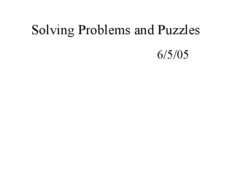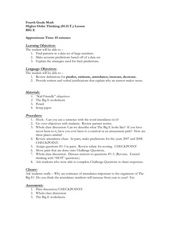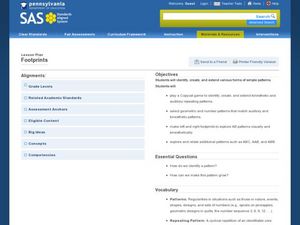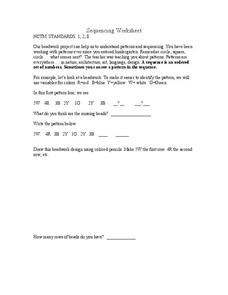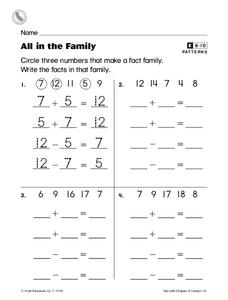Balanced Assessment
Number Trick
Show your classes the magic of numbers. Using a number trick, learners practice writing algebraic expressions. They then use their expression to perform the trick. Their exploration should help them understand the magic behind the trick.
Didax
Pi Day #1a – Discovering Pi
Unravel the mystery behind the infamous number pi. Scholars complete a series of activities that explores where pi comes from, its digits and estimation strategies. Pupils should be ready to measure, calculate, and look for patterns to...
Illustrative Mathematics
Making a Ten (Grade 1)
How many ways can first graders make a 10? Using an addition chart, learners color in the 10s on the table. They notice and explain the meaning of the pattern, and how to get to another sum of 10.
Radford University
Fibonacci is All Around
One ratio to rule them all. Young mathematicians investigate the Fibonacci sequence and the Golden Ratio. To begin the first lesson, they use a spreadsheet to see how the Fibonacci sequence gives the Golden Ratio. The second lesson...
Curated OER
Addition: Number Bonds to 10
You have the answer and a variable, but something is missing! The class fills in the missing addend in 23 practice problems that all add up to 10. This is a great way to build number sense, pattern recognition, and automaticity.
Curated OER
Building Big Ideas in Math: Frog Themed
For this math patterns worksheet, students work to find the math pattern in 'The Lost Button' story. Students answer six questions about math patterns.
Curated OER
Domain: Operations and Algebraic Thinking
Practice basic operations for young mathematicians in fun ways! Using two decks of cards (Ace through 10 plus the joker), learners play "memory" by matching numbers that can be added to make 10 and writing number sentences. In another...
Curated OER
Solving Problems and Puzzles 1
Plug in this presentation for a quick start to your day. The class reviews the 6 times tables how they relate to division and then work through patterns to build logical reasoning and sequencing skills. A wonderful warm up or problem...
Teach Engineering
Discovering Phi: The Golden Ratio
Fe, phi, fo, fum. This activity leads pairs to find the ratio of consecutive terms of the Fibonacci sequence. The pairs find that the Fibonacci sequence can be found in many places. A discussion with the class shows that the ratios found...
Curated OER
There's Gold in Them Thar Ratios
Students draw a model of the bunny problem which generates the Fibonacci Sequence, spirals generated from golden rectangles and golden triangles; identify the golden ratio in the human body, and find the Fibonacci numbers in nature.
Curated OER
Hide and Seek
In this patterns worksheet, 3rd graders, working with a partner, look at 6 groups of numbers, one partner covers one group of numbers, the other partner writes down the numbers they remember and together they look for a pattern in each...
Curated OER
Higher Order Thinking (H.O.T.) Lesson - BIG E
Fourth graders work with patterns while using large numbers. In this patterning lesson, 4th graders go over the definitions of the words: predict, estimate, attendance, increase, and decrease. They complete worksheets in which they track...
Curated OER
What's Missing?
In this patterns worksheet, 2nd graders look for the patterns in a given chart, write in the missing numbers and complete eight sentences involving answers from the chart.
Curated OER
Footprints
Students explore patterns. In this patterns geometry lesson, students identify and extend patterns including body parts, movement, geometric shapes, noises, and footprints. Students create and share an original pattern.
Curated OER
Sequencing Worksheet
For this patterns and sequencing worksheet, 9th graders complete 30 math problems that involve patterns and rules. Students must read information as they work through the math problems.
Curated OER
Counting by 3s- Random
In this counting by 3s learning exercise, students solve 5 problems in which a chart with a series of numbers is completed by skip counting by 3s. The series of numbers begin with random numbers anywhere between 3 and 100.
Pennsylvania Department of Education
Volume of Regular and Irregular Objects
Fifth graders examine patterns and relate to equations to solve math problems. In this patterns lesson, 5th graders diagram, graph, use models and use tables to solve equations for real world problems.
Curated OER
Multiples 4
In this recognizing multiples worksheet, students observe patterns of x's and draw the next sequences, write the number of crosses in the patterns and determine the rules for the sequences, and solve an exponent problem. Students solve...
Curated OER
Fill in the Fact Families
In this fact families and patterns activity, 2nd graders fill in the missing numbers in four houses and then write the fact family for each group of numbers.
Curated OER
All In the Family
In this fact family worksheet, learners analyze 5 numbers in a row. Students circle the 3 numbers that make a fact family and write the facts in that family. There are 4 problems.
Curated OER
Geoboard Squares
Students create squares of different sizes on a geoboard. They find and describe a pattern. Students use the pattern to determine the number of squares possible on a 10-by-10 geoboard. They create squares with a horizontal base (and...
Curated OER
Swimmy's Friends
Students solve problems using various strategies. For this problem solving lesson, students read the book Swimmy by Leo Lionni. Students make fish swimming patterns, measure how many goldfish crackers it takes to make a handprint and...
Curated OER
Tile Teasers
In this patterns worksheet, 3rd graders match tiles with the shapes in a larger image. Students copy the tiles into the squares of grid paper to create the specified design.
Curated OER
Functions and Graphing
Graphing functions in a real world application makes math come to life. Learners graph points on a coordinate plane and identify various points on a graph by working through a set of real world problems. This is a perfect review exercise.









